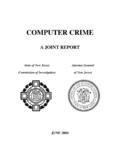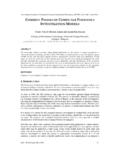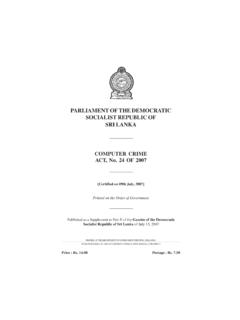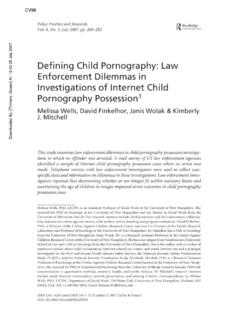Transcription of Framework for a Digital Forensic Investigation
1 Framework for a Digital Forensic Investigation Michael Kohn1, JHP Eloff2 and MS Olivier3. 1. Information and computer Security Architectures Research Group (ICSA). Department of computer Science University of Pretoria Abstract - computer Forensics is essential for the successful prosecution of computer criminals. For a Forensic Investigation to be performed successfully there are a number of important steps that have to be considered and taken. The aim of this paper is to define a clear, step-by-step Framework for the collection of evidence suitable for presentation in a court of law. Existing Forensic models will be surveyed and then adapted to create a specific application Framework for single computer , entry point forensics. 1. Introduction Over the past few years, computer forensics has risen to the fore as an increasingly important method of identifying and prosecuting computer criminals.
2 Prior to the development of sound computer forensics procedures and techniques, many cases of computer crime were left unsolved. There are many reasons why an Investigation might not lead to a successful prosecution, but the predominant one is a lack of preparation. The organization investigating the suspicious behaviour often lacks the tools and skills required to successfully gather evidence. Individuals attempting to investigate such suspicious activity may also lack the financial resources financial resources or tools to conduct such an Investigation adequately and ensure that the evidence is undisputable in all circumstances. Moreover, there are instances when all of the above have been adequately put in place by an organization, but, due to a lack of training and correct procedure, the evidence collected can easily be disputed.
3 As a result, computer forensics seeks to introduce cohesion and consistency to the wide field of extracting and examining evidence obtained from a computer at a crime scene. In particular, the extraction of evidence from a computer is performed in such a way that the original incriminating evidence is not compromised. This is also useful when presenting a case without the support of legal expertise, as is often the situation since many organizations and individuals do not have in-house or personal legal representation. This paper will propose a three phase Framework that can be followed systematically to produce forensically sound evidence. The Framework is an adaptation or combination of several existing Forensic models. The paper is structured as follows: the subsequent section will clarify important terminology used in the field of forensics; the third section will briefly discuss some generally accepted frameworks; section four will introduce the proposed Forensic Framework , and closing remarks will be made in section five.
4 2. Background According to the Oxford dictionary, the word Forensic is defined as relating to or denoting the application of scientific methods to the Investigation of crime and of or relating to courts of law [8]. At first, this appears to be quite a broad definition, but what is important in the first definition is that scientific methods are used in the Investigation and the second definition emphasizes the fact that Forensic activity usually relates to courts of law. Nonetheless, not all cases investigated end up in court. Examples are internal investigations and disciplinary hearings [7]. In conclusion, what would seem to be important is that, when a Forensic Investigation is launched, it is conducted in a scientific way and with a legal base as support.
5 Some authors make a clear distinction between computer and Digital forensics [5]. Yet, for the purposes of this paper, no real distinction is made. computer forensics can be defined as analytical and investigative techniques used for the preservation, identification, extraction, documentation, analysis and interpretation of computer media ( Digital data) which is stored or encoded for evidentiary and/or root cause analysis [7]. There are, however, methods which can help circumvent the, often tedious, task of ascertaining which factors are applicable to a particular Forensic Investigation . All organizations should have standards, policies and procedures in place that can assist in such an Investigation . Standards that are important here are ISO17799 [10] and COBIT.
6 [11]. These standards do not cover a Forensic Investigation , but could be used to aid it. As well as internal standards and policies, there are several legislative measures that support organizations attempting to prosecute computer crimes. In South Africa, there are a number of important Acts that can be referenced. These include the Electronic Communications and Transactions (ECT) [12] and the Promotion of Access to Information Act (PAIA) [13]. These, however, do not provide any clear guidelines as to how a Forensic Investigation should be conducted to ensure legal appropriateness. Consequently, an important way for most organizations to protect themselves against computer crime is to institute internal policies and procedures which specify exactly what constitutes harmful action against or within an organization.
7 These, however, are beyond the scope of this paper since there are a wide variety of possible solutions that can and have effectively been used. Thus far it has been determined that implementing certain Standards, like ISO17799, can be a useful initial step by an organization towards effectively protecting its information and assets. Moreover, that specific policies and procedures should also be implemented within an organization to help protect the internal integrity of information and assets. Once these basics are in place, the next step is to apply a sound Forensic Framework , which will consistently gather evidence suitable for presentation in a court of law, to ensure that criminal behaviour can be successfully prosecuted. The Oxford dictionary defines a Framework as a supporting or underlying structure [9].
8 A computer Forensic Framework can be defined as a structure to support a successful Forensic Investigation . This implies that the conclusion reached by one computer Forensic expert should be the same as any other person who has conducted the same Investigation [7]. A Framework is also dependent on a number of structures. In the case of computer forensics, or forensics in general, legislation has to be considered to be of prominent importance. A Forensic Investigation has to be conducted in a scientific manner and must comply with all legal requirements, as set out in the second definition of forensics above. Evidence will have to be collected in this manner irrespective of the purpose internal Investigation , disciplinary hearing or court case. 3. Frameworks There is an old saying that prevention is better than cure.
9 When applied to Forensic frameworks this would seem to imply that preparation is the key to conducting a successful Forensic Investigation . Although preparation is important, it is impossible to be prepared for all types of behaviour. A sound base of previous knowledge and experience will always help, but a suggestion or documented case is not a complete resolution to solving a problem. The number of Forensic models that have been proposed reveals the complexity of the computer Forensic process. Most focus on either the Investigation itself or emphasize a particular stage of the Investigation . Kruse and Heiser refer to a computer Forensic Investigation methodology with three basic components. They are: acquiring the evidence; authenticating the evidence, and analyzing the data [1].
10 These components focus on maintaining the integrity of the evidence during the Investigation . The United States of America's Department of Justice proposed a process model for forensics. This model is abstracted from technology. This model has four phases: collection; examination; analysis, and reporting. [5] There is a correlation between the acquiring the evidence' stage identified by Kruse and Heiser and the collection' stage proposed here. Analyzing the data' and analysis' are the same in both frameworks. Kruse has, however, neglected to include a vital component: reporting. This is included by the Department of Justice Framework . The Scientific Crime Scene Investigation Model proposed by Lee consists of four steps. They are: recognition; identification; individualisation, and reconstruction [1].






